
TARGET 110413
Towboat meets bridge
Tow boats guide barges loaded with coal down the Tombigbee river Mississippi. Near Demopolis, Alabama, the Rooster Bridge crosses the river. It has a narrow drawbridge on one side, and a very wide, low span of bridge on the other. Instead of trying to guide the loaded coal barges through the narrow span of the drawbridge, the tow boats customarily guide the barges toward the wide, low side, cut them loose, and let the current drift them under the bridge. The tow boats then race over to the drawbridge side, go through it easily, and then speed up to reconnect with their barges. They then hook up with the barges and continue down the river. That is how it was planned on April 28, 1979, but on that day, the river was at an all-time high, and the water was flowing much faster than normal. Just about everything that could go wrong did.
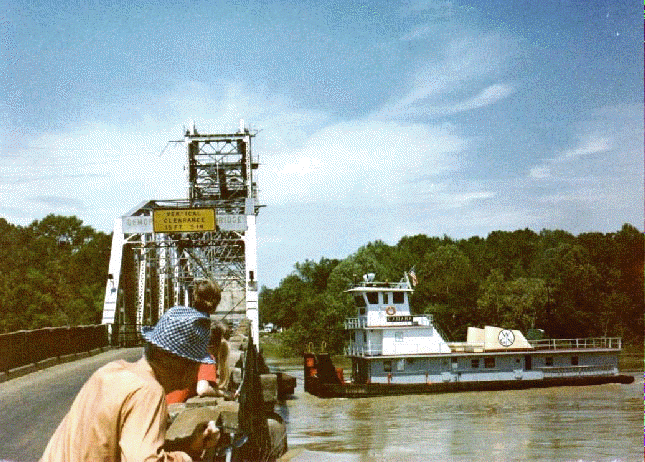
The tow boat CAHABA, commanded by Capt. Jimmy Wilkerson, approached the bridge, dropped its connection to two coal barges, to allow them to drift through the non-lifting East span of Rooster Bridge.
Pilot Earl Barnhart & 2 deckhands were placed on the tow to cast off the safety wires & winch wires. But for some unknown reason, the hands on the barges had taken loose all rigging except the starboard tow-knee wire on one of the barges loaded with coal.
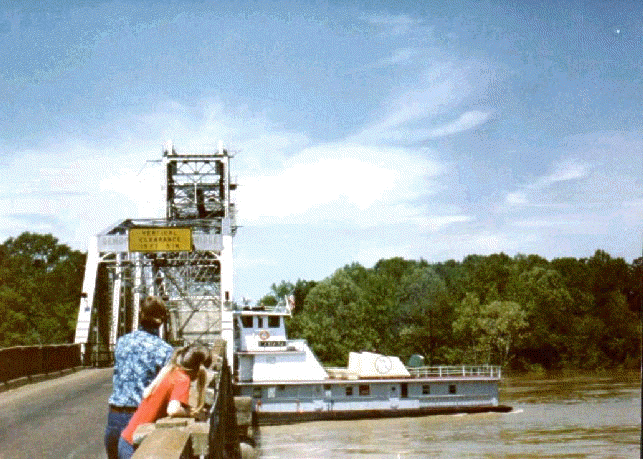
Wilkerson had dropped the barges in a non-opening area of the East bridge span where the current was less, with the intent of picking them up later -- and then intending to run Cahaba through the West section of bridge span that does open, while he was "light." But the unexpected water level and current was not taken into account. Added to that, the CAHABA was still tied to one of the barges, which had now passed under the bridge and was pulling the CAHABA with it. The CAHABA is backing as hard as possible to avoid collision with the non-opening East span of the bridge. This photo gives you an idea of how fast the river is running -- obviously at or near flood stage.
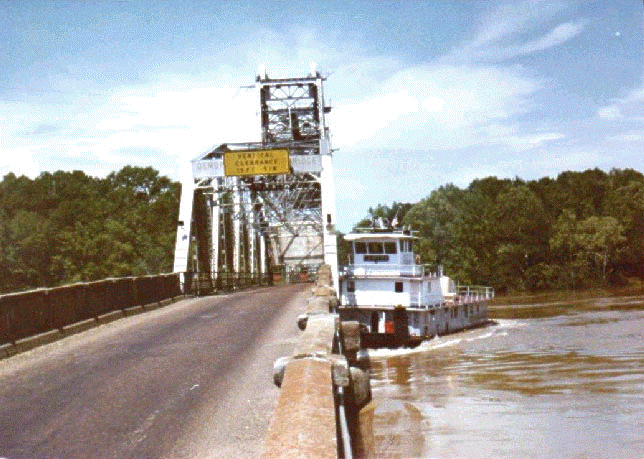
The CAHABA has now been pulled too close to the East span of the bridge. It is caught by the current. This is a macro example of what happens when canoe or kayak gets up against what is called a "strainer" -- a fixed obstacle where the current is roaring.
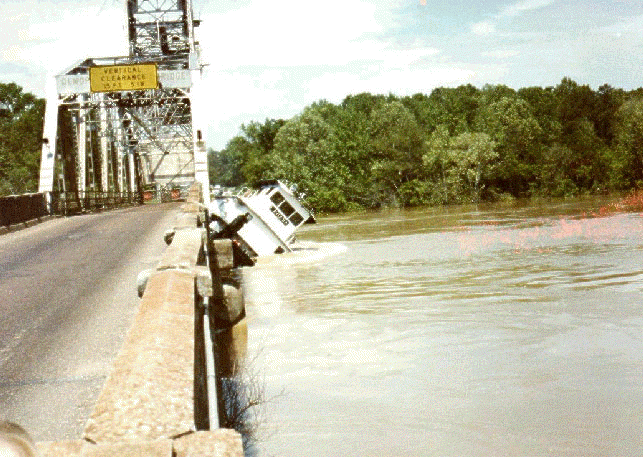
The Tombigbee's current has swung CAHABA around sideways. Now, there is no way to back against the current. The CAHABA is in deep trouble. Wilkerson had hope of escaping the current trap until CAHABA began to take an angle to the current. Now, he has none.
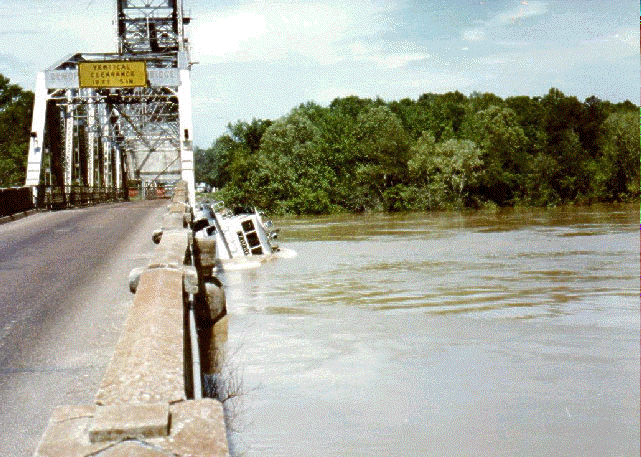
Next, the river current swings the boat fully sideways. CAHABA is trapped against the Rooster Bridge span starboard side to. Towboats like CAHABA have a substantial amount of draft (8 to 12 feet) and, when this large surface is facing the river current and trapped up against something, the boat starts rolling onto its side. With the upstream side now tilting downward, it starts catching the water and CAHABA is "out of business!"
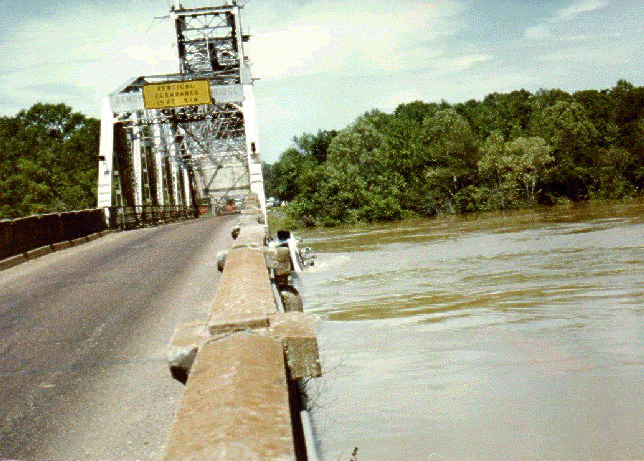
This is where we say, "Fairwell" to the CAHABA.
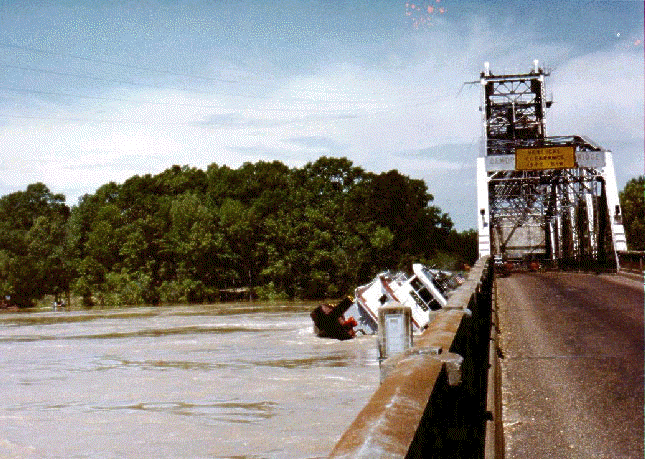
But what's this? Has the CAHABA survived? Please call those people who don't believe in miracles. CAHABA rolled completely onto her side. Has she "under achieved?" She passed UNDER the span and partially righted after clearing the Rooster Bridge. CAHABA's tow knee wire (still attached to the barge) had pulled the starboard tow knee on the CAHABA under the bridge. When the wire finally broke, the vessel popped up & hung the tow knee underneath the bridge. Do these people live right, or what?
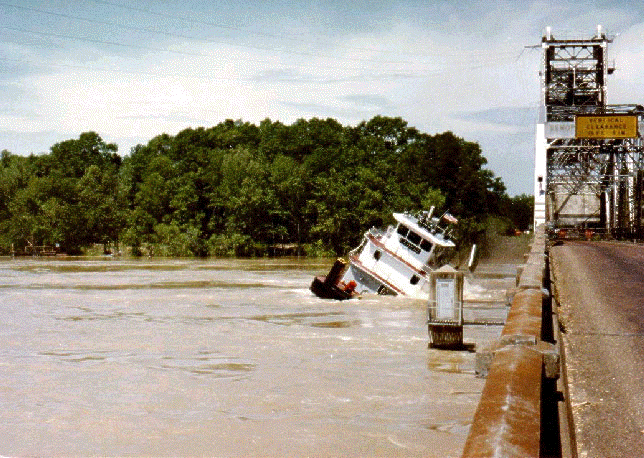
To the crew, below deck in the CABAHA, there is no way to understand what has happened.

She's now taken on water and is floating low, but at least she's still floating. Note that "Old Glory" is even still flying from atop the wheel house.
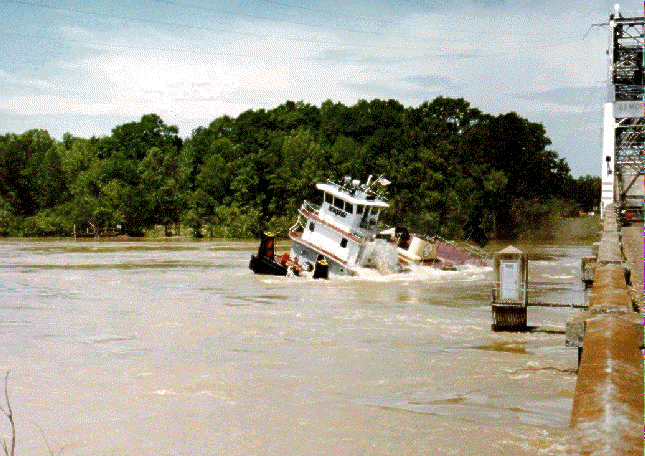
The wheelhouse door & door in the 2nd deck are now open. Look closely at bottom right-hand side of the picture & you will see that the bridge guardrail is underwater.
At one point, when the boat was completely horizontal, Capt. Wilkerson was straddling the port pilothouse door frame. During the time the pilothouse was immersed, the port front pilothouse window blew in, filling the space with water. But throughout the ordeal, he remained at the helm. This Captain literally did "Go down with the ship."
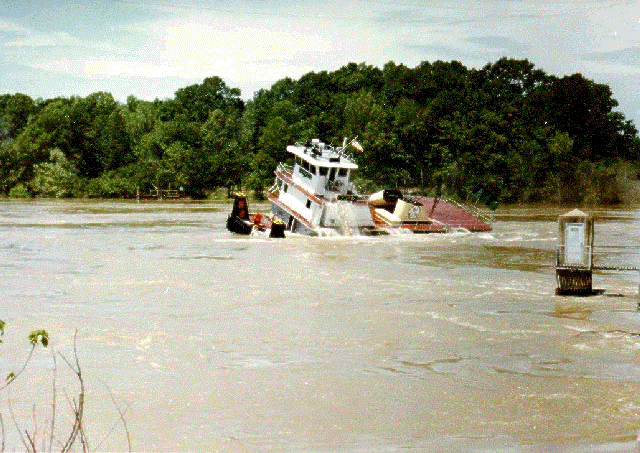
The working deck is still underwater, but CAHABA is rising. Look at the water pouring out of the 2nd deck doorway.

The working deck is still underwater, but CAHABA continues to rise. According to the crew, CAHABA had just topped off with fuel at Demopolis, 14 miles upstream. CAHABA has one central fuel tank forward of her engines. If that fuel tank had been 1/2 full, she probably never would have come back up.
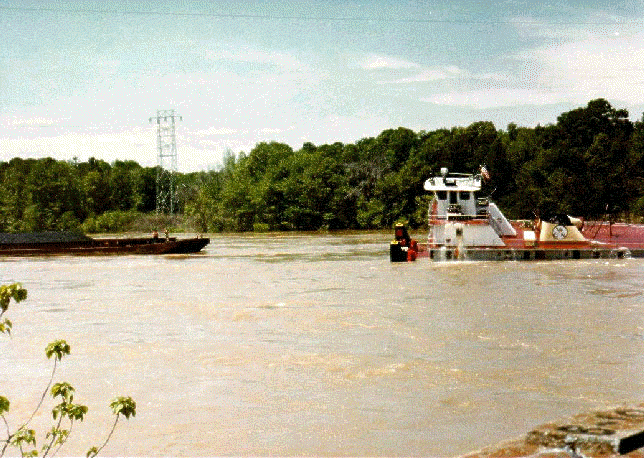
Key to survival: the engine is still running!!! Another key to survival: it is understood that the company owning the boat, Warrior Gulf Navigation Co., a subsidiary of Pittsburg Steel, ballasted all their vessels with 3 to 4 feet of cement in the bottom. Thus, the CAHABA righted itself as soon as it was free from the bridge - as it was designed to do.
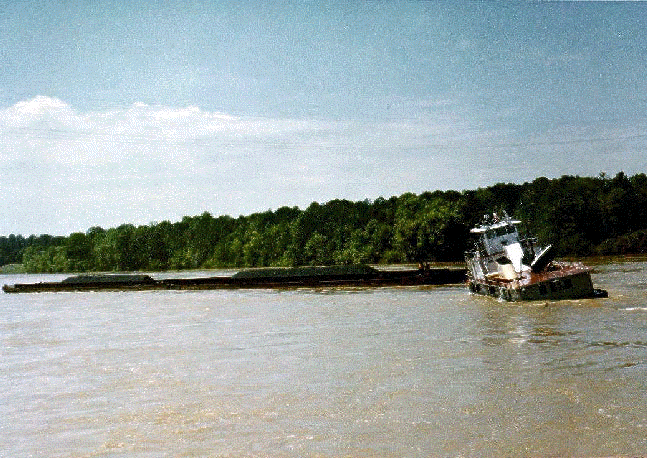
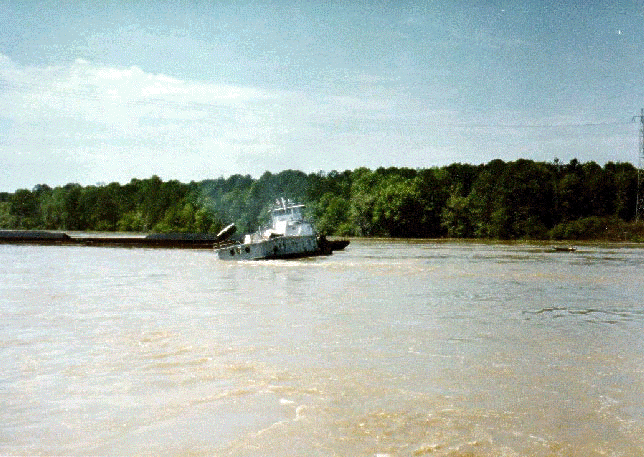
Still listing badly to her side, Capt. Wilkerson tries as hard as he can to catch the CAHABA up to its barges in order to keep them from beaching on the river's bank.
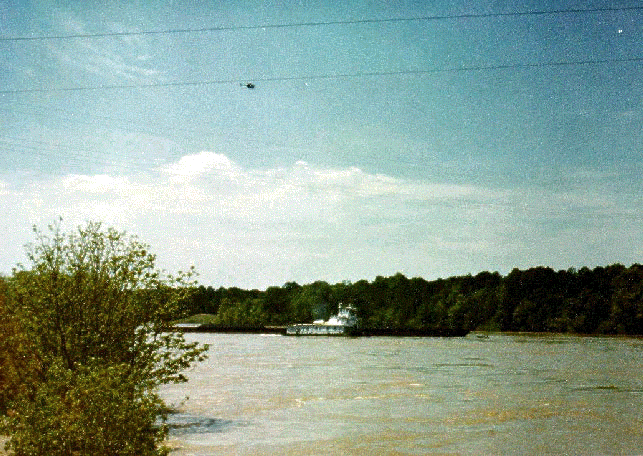
CAHABA reacquires its barges. However, she was burdened with the water she had taken on, and would have problems finishing the trip. There was another towboat named the M/V CATHY PARKER waiting upstream for her turn to pass through the bridge. CATHY PARKER radioed to Capt. Gary Grammer on M/V TALLAPOOSA (which was downstream below Blacks Bluff) that something had happened to the CAHABA. Capt. Grammer tied off TALLAPOOSA's barges and then "light-boated" to the CAHABA, where he pushed her out into a flooded corn field. TALLAPOOSA then rescued the 3 crew members and secured the 2 loose CAHABA barges.
Epilogue:
According to historical sources, the Tombigee River was running at an historically high level When this incident occurred. At Demopolis, Alabama the river was running at 73 feet. A typical flow is approximately 12-13 feet.
The CAHABA is still running the rivers but is now renamed M/V CAPTAIN ED HARRIS.FEEDBACK MAP
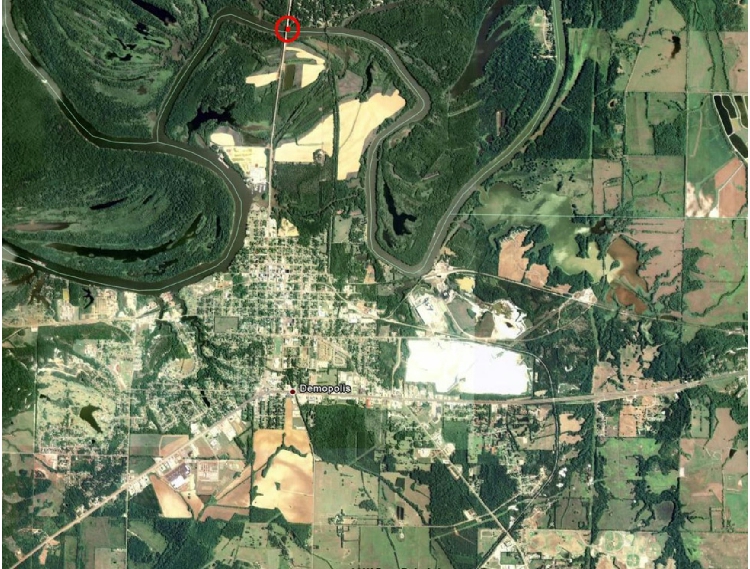
Many thanks to Ray McClure for suggesting and programming this target.